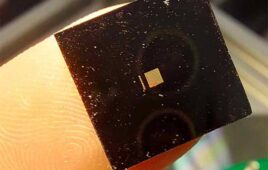
Scanning patterns of protein phosphorylation shows how sick hearts alter protein signaling pathways.
Having a big heart is not always a virtue – in fact, from a physiologist’s point of view, it can be deadly. An enlarged heart is a hallmark of a cardiovascular disease called dilated cardiomyopathy (DCM) and, despite being the most common inherited disease of the heart muscle, doctors don’t really know why it occurs. That could change after a new University of Toronto study that sheds light on the molecular causes behind DCM.
Published this week in the Proceedings of the National Academy of Sciences of the U.S., the study reveals widespread differences in protein biochemistry between healthy and diseased hearts. This expands our understanding of heart physiology and opens the door for future research that could improve the detection and treatment of cardiovascular disease.
Affecting all ages, the disease begins usually in adolescence and strikes 1 in 5 Canadians, with huge healthcare, economic and social costs. It occurs when a normal-looking heart begins to dilate or stretch, for no apparent reason. The enlarged heart can no longer maintain normal rhythm and pump blood, which leads to heart failure. Although we know that DCM is rooted in genetics, its molecular culprits are poorly understood.
Led by Professors Andrew Emili and Anthony Gramolini, the UT researchers mapped changes in protein signaling pathways in heart cells that lead to DCM. Emili, of the Donnelly Centre for Cellular & Biomolecular Research, is a molecular genetics professor; Gramolini, of the Ted Rogers Centre for Heart Research, is an associate professor in physiology at the school.
The Emili and Gramolini teams combined strengths to dig deep into the heart muscle and compare changes in protein signaling networks that are active in healthy and DCM hearts. Proteins are the end products of genes and do most of the work in cells. For example, heart growth during development is controlled by complex signaling networks among thousands of proteins.
This activity is often regulated by phosphorylation, a biochemical reaction in which a phosphate group is added to a protein to make it more or less active, change its position in the cell or mark it for destruction. By scanning the patterns of protein phosphorylation, the researchers were able to study how sick hearts ramp up, or dampen, entire protein signaling pathways which become vulnerable to heart failure.
“We decided to measure global protein phosphorylation in heart tissue to get a sense for how signaling pathways differ between DCM and normal hearts,” said Dr. Uros Kuzmanov, who spearheaded the project as a postdoctoral research fellow in both Emili and Gramolini labs. No such study had been attempted on such a scale in the past.
As a stand-in for human disease, Kuzmanov used mice that carry a mutation akin to one found in human patients, that makes them develop the signs of DCM. To get a better understanding of how the disease begins, the teams collected heart samples from young adult healthy and mutant mice when their heart muscles just began to stretch, for a side-by-side analysis. The researchers then ground the heart tissue to remove the proteins, which were fed into a mass spectrometer to be counted.
Based on changes in the levels of thousands of phosphorylated proteins, the researchers uncovered hundreds of signaling pathways that went off course in DCM hearts, marking the first comprehensive map of the molecular signaling events that go awry in heart failure.
The teams will next carry out similar analysis in human tissue. If, as expected, they can detect similarly robust changes in the same signaling pathways in patients’ hearts, the human map could help scientists nail down promising new drug targets or biomarkers for early detection.
“We expect to be able to detect specific changes in signaling pathways in different cardiac patients,” Kuzmanov said. “And our approach is not limited to the DCM—it could be applied to all heart disease.”
University of Toronto
utoronto.ca




